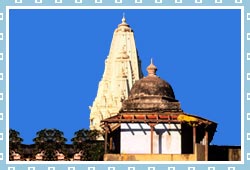 |
A Heritage Walk
Legend
As per the legend, water in the tank first sprang up when Lord Rama shot an arrow while resting here during a mission to save his wife Sita from the Demon King Ravana's abode in Lanka. As soon as the arrow was shot, water oozed out from the spot. The water in this tank is regarded as subsidiary of River Ganges, which actually flows five thousand miles away. Thus, the tank derived its name Banganga from two words-Baan (arrow) and Ganga (River Ganges). Legend relates Lord Rama and Lakshmana to the origin of Walkeshwar temple too. It is said that the Shiva Linga here was installed by Lord Rama after waiting too long for his brother Lakshmana who went to Benares to bring a Shiva Linga. It is believed that the original Shiva Linga was made by sand and the name Walkeshwar corresponds to that-Valuka Ishwar (idol made of sand).
Structure
Banganga Tank, today, is a rectangular-shaped pool surrounded by steps on all sides. At the entrance of the tank, stand two pillars bearing oil lamps or Diyas belonging to ancient days. The water of the tank still remains sweet despite the sea being located very near. Today, this sacred tank is visited by thousands who wish to take a dip in the holy water and offer flowers at the Banganga temple. The tank, along with the Walkeshwar Temple and the Parasuram temple, is owned by the 'Goud Saraswat Temple Trust' who owns most of the properties in the complex.
Major Attractions
The Banganga tank has a Walkeshwar temple adjacent to it. The Banganga complex also houses 'Shri Kashi Math' and ''Shri Kaivalya' or 'Kawle Math' in its banks and also has the 'samadhis' of the past heads of the Math. Nearby the Banganga tank lies other destinations such as Jain temple, the Hanging Gardens, Kamala Nehru Park and Priyadarshini Park.
One of the prominent attractions of Banganga tank is the two-day Banganga Music and cultural festival, which is conducted annually, in the month of February, by the Maharashtra Tourism Development Corporation (MTDC). During this time, the tank is cleaned and decorated and the festival aims at promoting Hindustani music. The festival witnesses the performances of music professionals as well as amateurs.